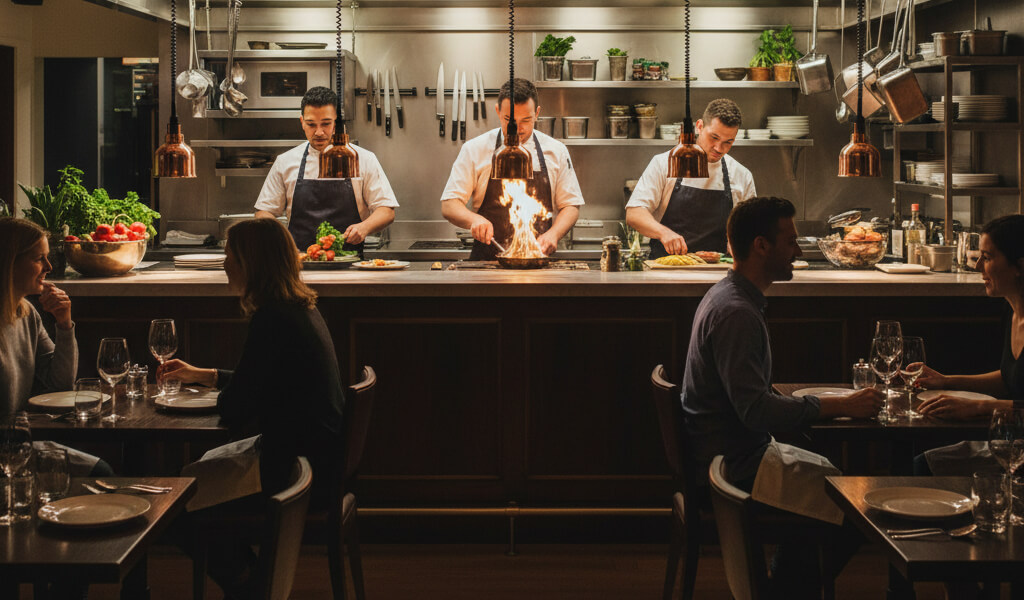October 06, 2025

Open kitchens aren’t just a design trend—they represent a strategic shift in how restaurants connect with their guests. In a competitive, experience-driven dining industry, visibility equals credibility. By inviting customers into the heart of meal preparation, restaurants are breaking down barriers, building trust, and delivering immersive dining experiences that boost loyalty, engagement, and long-term revenue.
Here’s why open kitchens work—and how restaurants can use them to their full advantage.
Modern diners want more than just great food—they want honesty. They want to know how their food is made, where it comes from, and who is preparing it. Open kitchens satisfy this demand by making the cooking process completely transparent. Customers can see the cleanliness of your workspace, the freshness of ingredients, and the professionalism of your staff in real-time.
This sense of openness builds subconscious trust. A guest who sees a gloved chef carefully plating a dish is more likely to feel confident about food safety and quality. It’s the same reason that transparency in digital marketing matters—whether it’s showing behind-the-scenes kitchen footage or partnering with real influencers, honesty resonates. As detailed in How Restaurants Can Use Influencers the Right Way, authenticity—not polish—is what drives connection and engagement both online and in person.
Research backs this up. A study from Harvard Business Review explains how transparency increases consumer trust, especially in industries (like food service) where customers typically lack full information.
Open kitchens aren’t just for aesthetics—they also empower diners who are selective about what they eat. Whether it’s due to allergies, religious restrictions, or personal values (like veganism), customers increasingly want to know that their food is handled with care and integrity.
When diners can observe plant-based or allergen-free dishes being prepared in a separate area—or even just with different utensils—they feel more secure in their choices. It’s visual assurance. It reinforces trust without requiring a word from the server.
This ties directly into the rising demand for ethical and plant-forward dining, as discussed in Plant-Based Dining: How Restaurants Can Market Vegan Options. Visibility is a powerful marketing tool, especially for restaurants catering to dietary-conscious or sustainability-minded guests.
The open kitchen isn’t just about customer psychology—it also affects your team. When staff know they’re “on stage,” performance improves. Chefs and line cooks tend to exhibit higher levels of focus, cleanliness, and professionalism in open kitchens compared to back-of-house setups. This doesn’t mean adding pressure—it means increasing pride, collaboration, and awareness.
Open kitchens can also help reduce communication breakdowns between front and back of house, especially when integrated with smart kitchen tech. POS screens, timers, and connected prep stations help keep things flowing smoothly in real time.
The link between visibility and accountability is also reflected in workforce management trends. As seen in Reducing Turnover with Better Tech, integrating the right systems not only improves workflow, but also leads to better retention, stronger team culture, and reduced training costs—especially when new employees are coached in a performance-visible space like an open kitchen.
Today’s diners are seeking experiences, not just meals. An open kitchen adds an interactive, almost theatrical element to the restaurant visit. The sounds of sizzling pans, the flash of flames, the cadence of chefs calling out orders—these all contribute to an immersive, memorable environment that engages multiple senses.
When guests can watch their meal being crafted by hand, it adds value. It fosters appreciation for the culinary skill involved, deepening emotional connection to the food and the brand. It’s no coincidence that the “chef’s table” or counter seating near open kitchens has become highly desirable—even at premium prices.
Open kitchens also give restaurants a chance to capture this dynamic on camera. A few seconds of well-shot video content—chefs plating dishes, fire licking a grill, ingredients being tossed mid-air—can be used on social media, websites, or booking platforms to amplify interest. As outlined in How to Turn Website Visitors Into Paying Diners, visually driven marketing tactics like this boost conversion and reduce bounce rates by showing the experience, not just the menu.
According to Eater’s exploration, diners feel psychologically reassured when they see meals being made in real time—often equating visual openness with food quality, even when they don’t consciously realize it.
Let’s be honest—open kitchens are Instagram gold. In an age where people eat with their eyes (and phones), having a beautiful, bustling, and visible kitchen provides a steady stream of marketing content. It humanizes your brand, spotlights your team, and communicates a message of “we’ve got nothing to hide.”
Behind-the-scenes stories of chefs prepping dishes or plating food are some of the most engaging types of content on platforms like TikTok, Instagram Reels, and YouTube Shorts. By sharing this kind of material, restaurants can tap into the authenticity-first model of online engagement. It’s not about being flawless—it’s about being real.
And when that online engagement ties into your reservation system, the results are measurable. Social proof drives bookings, especially when your content highlights the unique atmosphere of your restaurant. A well-filmed chef at work can spark more interest than a menu PDF ever could.
Open kitchens are much more than a design element—they’re a business tool that touches nearly every aspect of a restaurant’s success. They build trust through transparency. They support marketing through visual content. They enhance the guest experience, empower dietary-aware diners, and create healthier internal cultures for staff.
And when combined with the right technology, branding, and operational systems, open kitchens can become a signature asset—a literal and figurative window into your restaurant’s values.
In a world where diners crave connection, storytelling, and trust, letting them see how the magic happens might just be your most powerful move.
Stay up to date with the latest tips, expert insights, product reviews, and step-by-step guides to help you grow, create, and succeed—no matter your industry or passion.